Step-by-step instructions for pruning apple trees in spring for beginner gardeners
Pruning is a mandatory procedure for caring for fruit trees. The yield directly depends on the quality of crown formation. The frequency of pruning also affects the general condition of the plant, its resistance to diseases and negative environmental factors, and aesthetics.
The apple tree can be pruned in the fall and late winter, but the best time for the procedure is spring. During this period, the most comfortable weather for both the gardener and the plant. All wounds heal quickly, new shoots are formed.
The content of the article
The goals of spring pruning apple trees
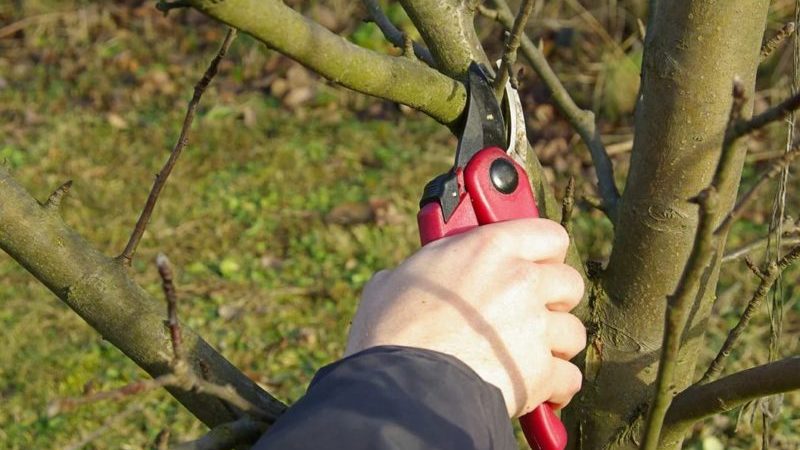
Pruning apple trees in autumn or spring is a mandatory procedure for caring for fruit and berry trees. The taste and quantity of the harvest, the general well-being of the plants depend on the quality of its implementation.
Pruning serves a number of purposes:
- Restoration of the exchange of substances between the underground and surface parts.
- Increased productivity. When removing excess branches and shoots, an intensive supply of nutrients begins in the ovaries and fruits, and not in the green mass. This leads to an increase in the taste and size of the fruit, yield.
- Growth of young shoots. Pruning old branches provokes the ejection of new shoots.
- Prevention of diseases and pests. By removing old branches, the grower reduces the risk of fungi, bacteria and insect overwintering.
- Improving air exchange, eliminating shading. When you remove excess branches, air begins to circulate correctly in the crown, the fruits are illuminated by the sun from all sides. The tree begins to ache less, the harvest ripens faster.
- Improving the aesthetics and convenience of harvesting. A compact tree with a neat crown adorns the garden. With proper pruning, the grower can easily reach each fruit.
- Saving space. In small areas, well-formed trees are placed in larger numbers.
- Increased tree life. The procedure allows you to rejuvenate apple trees that have begun to give poor yields.
Advantages and disadvantages of the procedure in the spring
Most gardeners prefer to prune the crown in the spring when the tree is still dormant. Such pruning times have several advantages:
- Removing branches during this period will not harm the plant. Pruning damage heals quickly. The plant is not stressed.
- Very little time passes after pruning, and sap flow resumes. The plant no longer needs to waste energy on old branches. The growth of new strong shoots begins, the formation of a large number of ovaries.
- During the winter, weak shoots freeze over, cracks form on some branches, at the end of autumn pests are introduced into the damaged tree. In summer, this takes away the strength of the plant, increases the risk of developing diseases. Problems can be easily avoided by pruning in the spring.
- It often rains in autumn, during which pruning is inconvenient. In spring, the temperature is comfortable for both gardening and plants.
- In the spring, there are no such negative factors as hot, dry weather, scorching rays of the sun. All this often causes deterioration of the tree during summer pruning.
The spring procedure also has disadvantages.Newbie gardeners sometimes confuse frost-stricken and not yet awakened branches and cut off the necessary parts of the tree. Pruning briefly inhibits plant development, so crops often mature later.
Note! The apple tree is a frost-resistant plant that can even withstand winter pruning, so some gardeners carry out the procedure at the end of February.
What happens if you do not cut the apple tree
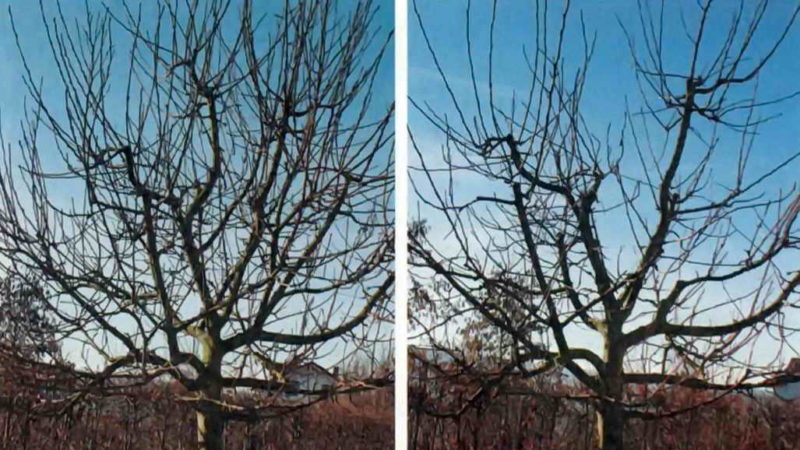
Pruning apple trees is a procedure that needs to be done every year. Beginners often neglect it, believing that the thicker the crown, the higher the yield. However, if you do not cut the apple tree, a number of problems arise:
- Diseases and pests... Risk factors - impaired air circulation in the crown, damaged and frostbitten branches, cracks in the bark. Also, an unnecessarily thick crown causes a decrease in immunity.
- Rotting fruit. If the crown is too thick, the apples do not ripen and fall off, and those affected by pests rot right on the branches. Up to 80% of the crop suffers from this problem.
- Decrease in yield, deterioration in fruit quality. If the crown is too dense, the plant spends energy on building up green mass, and not on developing fruits. Apples become small, sour, some of the ovaries fall off. The apple tree spends more and more energy on recovery, does not bear fruit every year, and over time it stops yielding altogether.
- Inconvenient and unaesthetic shape. Uncut trees look sloppy. It is inconvenient to get fruits from the dense crown.
- Short lifespan. Over time, the trees grow old, stop yielding, dry out. It is possible to save the plant with the help of anti-aging pruning.
When to prune in spring
Spring pruning is recommended when the outside temperature is already above zero. It is important to do this before the buds open. Otherwise, the wounds will heal for a long time, the plant will experience severe stress, all processes will be inhibited. This year the apple tree will not yield at all.
In the Moscow region and other regions of the central part of Russia, the procedure is carried out at the end of March. By this time, the snow should have thawed. If the drifts are still there, the procedure is postponed.
In the northern regions, trees are pruned in April. In the south - in early March or late February.
Note! The outside temperature during pruning can be below zero, but not lower than -5 ° C.
Types of trimming
There are 3 types of trimming. Each of them has its own goals. It is important not to neglect any of them.
It is interesting! Different schemes are used for trimming. The crown of a spherical shape looks the most aesthetically pleasing.
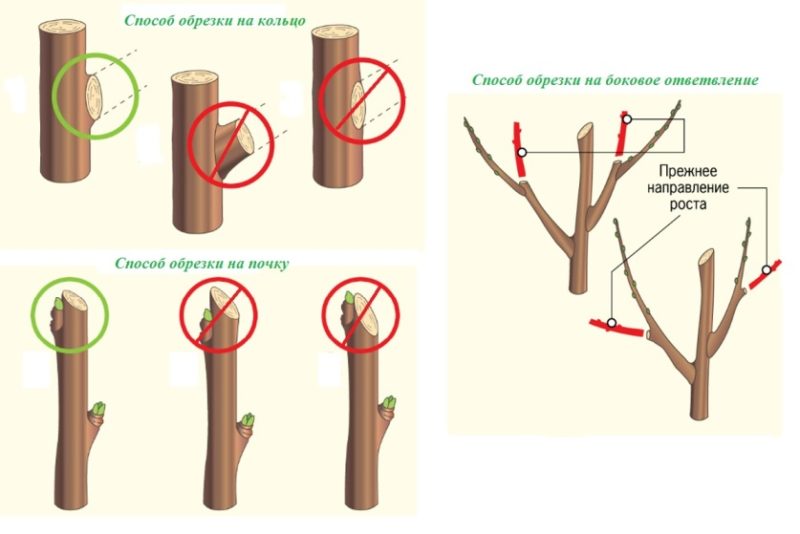
Formative
Formative pruning is necessary to form the correct crown shape. Usually they choose a ball-shaped one, but some gardeners prefer a fan-shaped or pyramidal one.
With this pruning, only the effective, necessary branches are left. This brings flowering and fruiting closer, reduces the risk of disease and pests, improves air circulation, reduces the likelihood of breakage, and promotes optimal distribution of nutrients.
At first, the procedure for pruning an apple tree is aimed at forming the correct skeleton. Further - to maintain shape, volume and density.
The timing and frequency of pruning depends on the growth rate. Fast-growing varieties are cultivated annually, and slow-growing ones - once every 2-3 years.
Anti-aging
Anti-aging pruning is used to prolong the life of old apple trees. It is not produced every year. Old trees are rejuvenated once every 6 years. The procedure allows you to restore the balance between growth and fruiting, which is upset with age.
When choosing the timing of anti-aging pruning, attention is paid to the condition of the tree. The need for the procedure is indicated by:
- a 15% decrease in annual growth;
- excessive flowering with poor fruiting;
- shedding of ovaries.
The procedure itself involves a significant shortening of old branches. A new crown is formed from strong, young, well-planted shoots.If the problem is running, it will take several years for a good cut.
Regulatory
Regulatory pruning is a complex procedure. It includes formative and sanitary trimming elements.
In the process, branches are removed that are too close to each other, inclined close to the trunk, directed towards the inside of the crown. Sick, weak, dry and old shoots are removed.
Such pruning is carried out not at any specific time, but as needed. Before work, you must carefully examine the plant, removing all unnecessary parts.
How to prune an apple tree
An adult apple tree is pruned, observing the basic rules. In this case, the procedure will benefit the tree, not harm.
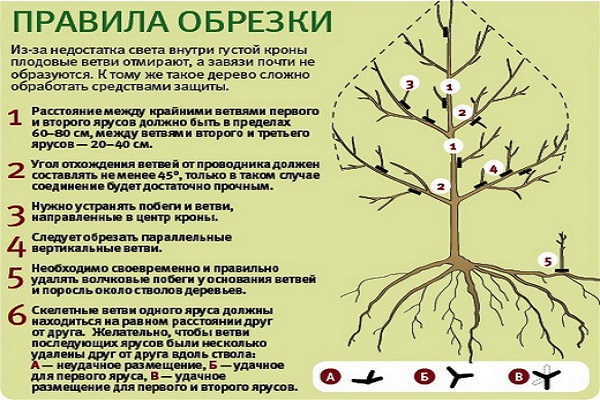
Required materials and tools
For high-quality pruning of wood, you will need special tools:
- Saw with fine and fine teeth. It is used to trim thick branches. Do not use a blunt saw with bent or broken teeth. It is dangerous for both the gardener and the plant.
- Secateurs. Used to trim the tops of shoots and root shoots. It must be sharp and powerful. Some gardeners use a garden knife.
- Ladder or stepladder to reach the branches at the top of the crown.
- A means for processing slices. Most gardeners use a garden variety.
- Paint. The lower part of the trunk is painted with it.
Step-by-step instruction
Pruning is a simple procedure. You just need to follow the step-by-step instructions:
- The tree is examined. All shoots damaged during the winter, dry branches, areas with damaged bark are removed.
- The apple tree should have only 5-6 skeletal branches pointing in different directions. If there are more of them, the extra ones are cut off. The branches are removed, directed inside the crown or up; shoots that touch the ground. If the branches are crossed, one of them is removed. Excess branches are cut off at the very trunk, without leaving hemp. If the tree is too tall, the skeletal branches are cut by a third.
- Thick branches (not skeletal) that touch, prevent each other from growing, go into the crown, and cut them off.
- All weak shoots are removed.
- The branches of the new growth are shortened by a third.
- All root growth is cut out.
The branches are cut at an angle of 45 °. The lower edge of the cut should be at eye level, and the upper one 1.5 cm higher.
All sections must be treated with garden pitch. Do this right after cutting the branch. No more than a third of the crown volume is removed at a time. The rule also works for anti-aging pruning.
Features of the procedure
The pruning technology differs depending on the age and variety. This must be taken into account when carrying out the procedure.
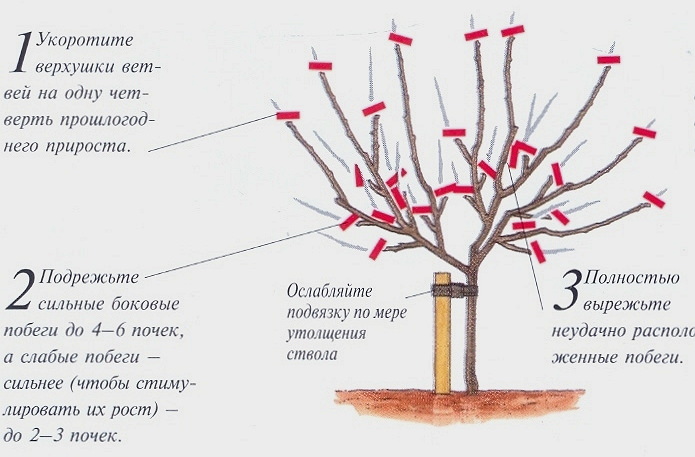
Nuances for columnar apple trees
The main feature of columnar varieties is the non-spreading crown that forms around the trunk. Pruning is carried out as follows:
- In the first year after planting, all side shoots are cut off.
- In the second year, pinch the growth point of branches that are more than 30 cm long. The upper branch is not touched, since it performs the function of continuing the trunk.
- The third year is the time for re-shortening of all lateral shoots. The central branch is shortened at a height of 25 cm.
- Further, all weak branches are cut off, as well as shoots directed inside the crown and located close to each other.
- A 5-year-old tree is cut off to stop growth.
- Mature trees undergo sanitary and regulatory pruning.
The nuances of pruning young and old apple trees
Young and old apple trees are pruned differently. In the first case, the procedure is aimed at the formation of the correct skeleton, in the second - at the removal of old branches, rejuvenation.
For the first time, the apple tree is pruned immediately after planting. This will allow the plant to grow properly.
A detailed lesson on pruning a young apple tree:
- Immediately after planting, the main trunk is cut. The optimal height for it is 80-100 cm. If the trunk is divided into 2 branches, one of them is cut off, leaving the stronger one. If there are already shoots in the first year, they are shortened by a third.
- In the second and third years, the crown is formed. Leave up to 6 shoots growing in different directions. The branches directed inside the crown are removed. The rest are shortened by a third.
- It is important to constantly cut the root growth, on which the plant expends energy. Do the same with dry, frozen and damaged shoots.
Old trees need rejuvenation. When trimming them, a different technology is used:
- First, all old, dry, diseased branches are removed.
- With rejuvenating pruning, move from the south side. Old branches are cut down. Leaves strong shoots with lots of greenery. They form a skeleton.
- The branches of tall apple trees are shortened by 50%, and the branches of low and medium-sized ones - by 30%.
- The northern half is started when the trimmed part begins to bear fruit.
Anti-aging pruning will only work if the trunk is intact. Having healthy skeletal branches is important.

Care after pruning
After pruning, the tree is given regular and proper maintenance. So it will more easily endure the procedure, it will not hurt, it will not stop growing.
Care rules after pruning:
- All sections must be covered over. Most gardeners use a garden pitch that is heated before use. You can replace it with a mixture of clay and mullein.
- Slices less than 1 cm in diameter do not need to be smeared. It is enough to clean them of sawdust and grind them.
- To stimulate the growth of new shoots, nitrogen fertilizers are applied: the first time - in early April, the second - in June. As nitrogen top dressing use organic matter (cow dung, chicken manure, compost) or mineral fertilizers (ammonium nitrate, ammophoska, urea).
- Phosphate fertilizers will be needed. They are brought in in April. 35 g of superphosphate or ash are buried under the tree.
- The day after fertilization, the apple tree is watered abundantly. The next day, the soil is loosened.
What to do if there is nothing to cut
If there is nothing to trim, the growth of new shoots is not observed, it is worth reconsidering the care. This situation indicates that the tree is uncomfortable. The reasons may be as follows:
- The close location of groundwater. When the root system is fully formed, it will reach the cold water table. This will lead to growth arrest, root rot, and fungal infections. To avoid this problem, you need to know the optimal planting depth for different varieties. For tall - 2.5 m, medium - 1.5 m, undersized - 1 m. To save a tree, you need a cardinal pruning. In such conditions, the plant should not be higher than 2 m.
- Poor soil. The apple tree lacks nutrients, which inhibits its development. To remedy the situation, manure or humus is introduced under the roots in spring and autumn, and mowed grass is piled up at the end of summer. Peas are planted in the trunk circle, and then their tops are dug into the ground. After a few years of such maintenance, the soil fertility will increase.
- Unsuitable climate. If the apple variety is not suitable for a particular region, the plant will develop slowly and die within 5 years. It will not be possible to solve the problem, you will have to get rid of the plant.
It is interesting:
A beginner gardener's guide step by step: how to plant an apple tree in spring
How to properly and how to spray apple trees from pests in summer
A step-by-step guide to planting a closed-root apple tree in summer
Conclusion
Apple pruning is a mandatory annual procedure. It is necessary to increase yields, maintain the shape of the crown, and protect against diseases and pests. Without it, the tree will cease to produce crops, begin to dry out and die.